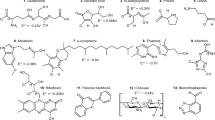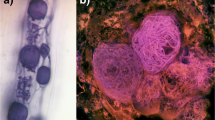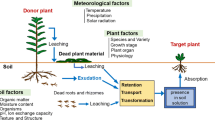Abstract
Both plant competition and plant defense affect biodiversity and food web dynamics and are central themes in ecology research. The evolutionary pressures determining plant allocation toward defense or competition are not well understood. According to the growth–differentiation balance hypothesis (GDB), the relative importance of herbivory and competition have led to the evolution of plant allocation patterns, with herbivore pressure leading to increased differentiated tissues (defensive traits), and competition pressure leading to resource investment towards cellular division and elongation (growth-related traits). Here, we tested the GDB hypothesis by assessing the competitive response of lima bean (Phaseolus lunatus) plants with quantitatively different levels of cyanogenesis—a constitutive direct, nitrogen-based defense against herbivores. We used high (HC) and low cyanogenic (LC) genotypes in different competition treatments (intra-genotypic, inter-genotypic, interspecific), and in the presence or absence of insect herbivores (Mexican bean beetle, Epilachna varivestis) to quantify vegetative and generative plant parameters (above and belowground biomass as well as seed production). Highly defended HC-plants had significantly lower aboveground biomass and seed production than LC-plants when grown in the absence of herbivores implying significant intrinsic costs of plant cyanogenesis. However, the reduced performance of HC- compared to LC-plants was mitigated in the presence of herbivores. The two plant genotypes exhibited fundamentally different responses to various stresses (competition, herbivory). Our study supports the GDB hypothesis by demonstrating that competition and herbivory affect different plant genotypes differentially and contributes to understanding the causes of variation in defense within a single plant species.






Similar content being viewed by others
References
Adler LS, Seifert MG, Wink M, Morse GE (2012) Reliance on pollinators predicts defensive chemistry across tobacco species. Ecol Lett 15:1140–1148. doi:10.1111/j.1461-0248.2012.01838.x
Agrawal AA (2007) Macroevolution of plant defense strategies. Trends Ecol Evol 22:103–109. doi:10.1016/j.tree.2006.10.012
Agrawal AA (2011) Current trends in the evolutionary ecology of plant defence. Funct Ecol 25:420–432. doi:10.1111/j.1365-2435.2010.01796.x
Agrawal AA, Fishbein M (2006) Plant defense syndromes. Ecology 87:S132–S149
Agrawal AA, Conner JK, Rasmann S (2010) Tradeoffs and negative correlations in evolutionary ecology. In: Bell MA, Eanes WF, Futuyma DJ, Levinton JS (eds) Evolution after Darwin: the first 150 years. Sinauer, Sunderland
Atsatt PR, O’Dowd DJ (1976) Plant defense guilds. Science (80-) 193:24–29
Baldwin IT, Hamilton W (2000) Jasmonate-induced responses of Nicotiana sylvestris results in fitness costs due to impaired competitve ability for nitrogen. J Chem Ecol 26:915–952
Baldwin IT, Sims CL, Kean SE (1990) The reproductive consequences associated with inducible alkaloidal responses in wild tobacco. Ecology 71:252–262
Ballhorn DJ (2011a) Cyanogenic glycosides in nuts and seeds. In: Preedy VR, Watson RR, Patel VB (eds) Nuts and seeds health and disease prevention (1st edn). Elsevier, Amsterdam, pp 129–136
Ballhorn DJ (2011b) Constraints of simultaneous resistance to a fungal pathogen and an insect herbivore in lima bean (Phaseolus lunatus L.). J Chem Ecol 37:141–144. doi:10.1007/s10886-010-9905-0
Ballhorn DJ, Lieberei R, Ganzhorn JU (2005) Plant cyanogenesis of Phaseolus lunatus and its relevance for herbivore–plant interaction: the importance of quantitative data. J Chem Ecol 31:1445–1473. doi:10.1007/s10886-005-5791-2
Ballhorn DJ, Heil M, Pietrowski A, Lieberei R (2007) Quantitative effects of cyanogenesis on an adapted herbivore. J Chem Ecol 33:2195–2208. doi:10.1007/s10886-007-9380-4
Ballhorn DJ, Kautz S, Lion U, Heil M (2008a) Quantitative variability of lima bean’s VOC boquets and its putative ecological consequences. Plant Signal Behav 3:1005–1007. doi:10.1111/j.1365-2745.2008.01404.x. www.landesbioscience.com
Ballhorn DJ, Kautz S, Lion U, Heil M (2008b) Trade-offs between direct and indirect defences of lima bean (Phaseolus lunatus). J Ecol 96:971–980. doi:10.1111/j.1365-2745.2008.01404.x
Ballhorn DJ, Kautz S, Heil M, Hegeman AD (2009) Cyanogenesis of wild lima bean (Phaseolus lunatus L.) is an efficient and direct defense in nature. PLoS ONE e5450
Ballhorn DJ, Pietrowski A, Lieberei R (2010) Direct trade-off between cyanogenesis and resistance to a fungal pathogen in lima bean (Phaseolus lunatus L.). J Ecol 98:226–236. doi:10.1111/j.1365-2745.2009.01591.x
Ballhorn DJ, Kautz S, Jensen M, Schmitt I, Heil M, Hegeman AD (2011a) Genetic and environmental interactions determine plant defences against herbivores. J Ecol 99:313–326. doi:10.1111/j.1365-2745.2010.01747.x
Ballhorn DJ, Schmitt I, Fankhauser JD, Katagiri F, Pfanz H (2011b) CO2-mediated changes of plant traits and their effects on herbivores are determined by leaf age. Ecol Entomol 36:1–13. doi:10.1111/j.1365-2311.2010.01240.x
Ballhorn DJ, Godschalx AL, Kautz S (2013a) Co-variation of chemical and mechanical defenses in lima bean (Phaseolus lunatus L.). J Chem Ecol 39:413–417. doi:10.1007/s10886-013-0255-6
Ballhorn DJ, Kautz S, Heil M (2013b) Distance and sex determine host plant choice by herbivorous beetles. PLoS ONE 8(2):e55602
Ballhorn DJ, Kautz S, Schädler M (2013c) Induced plant defense via volatile production is dependent on rhizobial symbiosis. Oecologia 172:833–846
Ballhorn DJ, Kay J, Kautz S (2014) Quantitative effects of leaf area removal on indirect defense of lima bean (Phaseolus lunatus) in nature. J Chem Ecol (in press)
Barton KE (2007) Early ontogenetic patterns in chemical defense in Plantago (Plantaginaceae): genetic variation and trade-offs. Am J Bot 94:56–66. doi:10.3732/ajb.94.1.56
Bennett AE, Bever JD, Deane Bowers M (2009) Arbuscular mycorrhizal fungal species suppress inducible plant responses and alter defensive strategies following herbivory. Oecologia 160:771–779. doi:10.1007/s00442-009-1338-5
Bernays E, Graham M (1988) On the evolution of host specificity in phytophagous arthropods. Ecology 69:886–892
Bixenmann RJ, Coley PD, Kursar TA (2013) Developmental changes in direct and indirect defenses in the young leaves of the neotropical tree genus Inga (Fabaceae). Biotropica 45:175–184
Broz AK, Broeckling CD, De-la-Peña C et al (2010) Plant neighbor identity influences plant biochemistry and physiology related to defense. BMC Plant Biol 10:1–14
Campbell SA, Kessler A (2013) Plant mating system transitions drive the macroevolution of defense strategies. Proc Natl Acad Sci USA 110:3973–3978. doi:10.1073/pnas.1213867110
Casper BB, Jackson RB (1997) Plant competition underground. Annu Rev Ecol Syst 28:545–570
Caswell H (1989) Matrix population models, 2nd edn. Sinauer, Sunderland
Chase JM, Abrams PA, Grover JP et al (2002) The interaction between predation and competition: a review and synthesis. Ecol Lett 5:302–315. doi:10.1046/j.1461-0248.2002.00315.x
Cipollini D, Heil M (2010) Costs and benefits of induced resistance to herbivores and pathogens in plants. CAB Rev Perspect Agric Vet Sci Nutr Nat Resour 5:1–25. doi:10.1079/PAVSNNR20105005
Connell JH (1983) On the prevalence and relative importance of interspecific competition: evidence from field experiments. Am Soc Nat 122:661–696
Cork SJ (1996) Optimal digestive strategies for arboreal herbivorous mammals in contrasting forest types: why koalas and colobines are different. Aust J Ecol 21:10–20
Dantas VDL, Batalha MA (2012) Can antiherbivory resistance explain the abundance of woody species in a Neotropical savanna? Botany 90:93–99. doi:10.1139/B11-087
Dover BA, Noblet R, Moore RF, Culbertson D (1988) An improved artificial diet for Mexican bean beetles based on host preference. J Agric Entomol 5:79–86
Ehrlich PR, Raven PH (1964) Butterflies and plants: a study in coevolution. Evolution (NY) 18:586–608
Fenner M, Thompson K (2005) The ecology of seeds. Cambridge University Press, Cambridge
Flanders RV (1984) Comparisons of bean varieties currently being used to culture the Mexican bean beetle (Coleoptera: Coccinellidae). Environ Entomol 13:995–999
Frehner M, Conn EE (1987) The linamarin beta-glucosidase in Costa Rican wild lima beans (Phaseolus lunatus L.) is apoplastic. Plant Physiol 84:1296–1300
García MB, Ehrlén J (2002) Reproductive effort and herbivory timing in a perennial herb: fitness components at the individual and population levels. Am J Bot 89:1295–1302. doi:10.3732/ajb.89.8.1295
Haag JJ, Coupe MD, Cahill JFJ (2004) Antagonistic interactions between competition and insect herbivory on plant growth. J Ecol 92:156–167
Hayden KJ, Parker IM (2002) Plasticity in cyanogenesis of Trifolium repens L.: inducibility, fitness costs and variable expression. Evol Ecol Res 4:155–168
Hedges LV, Gurevitch J, Curtis PS (1999) The meta-analysis of response ratios in experimental ecology. Ecology 80:1150–1156
Heil M (2008) Indirect defence via tritrophic interactions. New Phytol 178:41–61
Herms DA, Mattson WJ (1992) The dilemma of plants: to grow or defend. Q Rev Biol 67:283–335
Johnson MTJ (2008) Bottom-up effects of plant genotype on aphids, ants, and predators. Ecology 89:145–154
Jones PR, Møller BL, Høj PB (1999) The UDP-glucose: p-hydroxymandelonitrile-O-glucosyltransferase that catalyzes the last step in synthesis of the cyanogenic glucoside dhurrin in Sorghum bicolor. J Biol Chem 274:35483–35491
Kakes P (1990) Properties and functions of the cyanogenic system in higher plants. Euphytica 48:25–43
Kaplan I, Dively GP, Denno RF (2009) The costs of anti-herbivore defense traits in agricultural crop plants: a case study involving leafhoppers and trichomes. Ecol Appl 19:864–872
Kempel A, Schädler M, Chrobock T et al (2011) Tradeoffs associated with constitutive and induced plant resistance against herbivory. Proc Natl Acad Sci USA 108:5685–5689. doi:10.1073/pnas.1016508108
Kost C, Heil M (2008) The defensive role of volatile emission and extrafloral nectar secretion for lima bean in nature. J Chem Ecol 34:1–13. doi:10.1007/s10886-007-9404-0
LaPidus JB, Cleary RW, Davidson RH et al (1963) Chemical factors influencing host selection by Mexican bean beetle Epilachna varivestis Muls. Agric Food Chem 11:462–463
Lieberei R (1988) Relationship of cyanogenic capacity (HCN-c) of the rubber tree Hevea brasiliensis to susceptibility to Microcyclus ulei, the agent causing South American leaf blight. J Phytopathol 122:54–67
Marak HB, Biere a, Van Damme JMM (2000) Direct and correlated responses to selection on iridoid glycosides in Plantago lanceolata L. J Evol Biol 13:985–996. doi:10.1046/j.1420-9101.2000.00233.x
Marak HB, Biere A, Van Damme JMM (2003) Fitness costs of chemical defense in Plantago lanceolata L.: effects of nutrient and competition stress. Evolution 57:2519–2530
Massad TJ, Dyer LA, Vega CG (2012) Costs of defense and a test of the carbon-nutrient balance and growth-differentiation balance hypotheses for two co-occurring classes of plant defense. PLoS ONE 7:e47554. doi:10.1371/journal.pone.0047554
Moles AT, Peco B, Wallis IR et al (2013) Correlations between physical and chemical defences in plants: tradeoffs, syndromes, or just many different ways to skin a herbivorous cat? New Phytol 198:252–263. doi:10.1111/nph.12116
Noitsakis B, Jacquard P (1992) Competition between cyanogenic and acyanogenic morphs of Trifolium repens. Theor Appl Genet 83:443–450
Nomura M, Hatada A, Itioka T (2011) Correlation between the leaf turnover rate and anti-herbivore defence strategy (balance between ant and non-ant defences) amongst ten species of Macaranga (Euphorbiaceae). Plant Ecol 212:143–155. doi:10.1007/s11258-010-9810-1
Rask L, Andréasson E, Ekbom B et al (2000) Myrosinase: gene family evolution and herbivore defense in Brassicaceae. Plant Mol Biol 42:93–113
Read J, Sanson GD, Caldwell E et al (2009) Correlations between leaf toughness and phenolics among species in contrasting environments of Australia and New Caledonia. Ann Bot 103:757–767. doi:10.1093/aob/mcn246
Rees M (1995) Community structure in sand dune annuals: is seed weight a key quantity? Oecologia 83:857–863
Rees M, Brown VK (1992) Interactions between invertebrate herbivores and plant competition. J Ecol 80:353–360
Richards AJ, Fletcher A (2002) The effects of altitude, aspect, grazing and time on the proportion of cyanogenics in neighbouring populations of Trifolium repens L. (white clover). Heredity 88:432–436
Selmar D, Lieberei R, Conn EE, Biehl B (1989) a -Hydroxynitrile lyase inHevea brasiliensis and its significance for rapid cyanogenesis. Physiol Plant 75: 97–101
Schädler M, Brandl R, Haase J (2007) Antagonistic interactions between plant competition and insect herbivory. J Ecol 88:1490–1498
Siemens DH, Garner SH, Mitchell-Olds T, Callaway RM (2002) Cost of defense in the context of plant competition: Brassica rapa may grow and defend. Ecology 83:505–517
Simms EL, Taylor DL (2002) Partner choice in nitrogen-fixation mutualisms of legumes and rhizobia. Integr Comp Biol 42:369–380
Stamp N (2003) Out of the quagmire of plant defense hypotheses. Q Rev Biol 78:23–55
Thamer S, Schädler M, Bonte D, Ballhorn DJ (2011) Dual benefit from a belowground symbiosis: nitrogen fixing rhizobia promote growth and defense against a specialist herbivore in a cyanogenic plant. Plant Soil 341:209–219. doi:10.1007/s11104-010-0635-4
Viola DV, Mordecai EA, Jaramillo AG et al (2010) Competition-defense tradeoffs and the maintenance of plant diversity. Proc Natl Acad Sci USA 107:17217–17222. doi:10.1073/pnas.1007745107
Wilson SD, Tilman D (1991) Component of plant competition along an experimental gradient of nitrogen availability. Ecology 72:1050–1065
Acknowledgments
Startup funds to D.J.B. from Portland State University are gratefully acknowledged. S.K. was supported by a postdoctoral fellowship (grant LPDS 2009-29) from the German Academy of Sciences Leopoldina. The authors declare that they have no conflict of interest.
Author information
Authors and Affiliations
Corresponding author
Additional information
Communicated by Diethart Matthies.
Rights and permissions
About this article
Cite this article
Ballhorn, D.J., Godschalx, A.L., Smart, S.M. et al. Chemical defense lowers plant competitiveness. Oecologia 176, 811–824 (2014). https://doi.org/10.1007/s00442-014-3036-1
Received:
Accepted:
Published:
Issue Date:
DOI: https://doi.org/10.1007/s00442-014-3036-1




